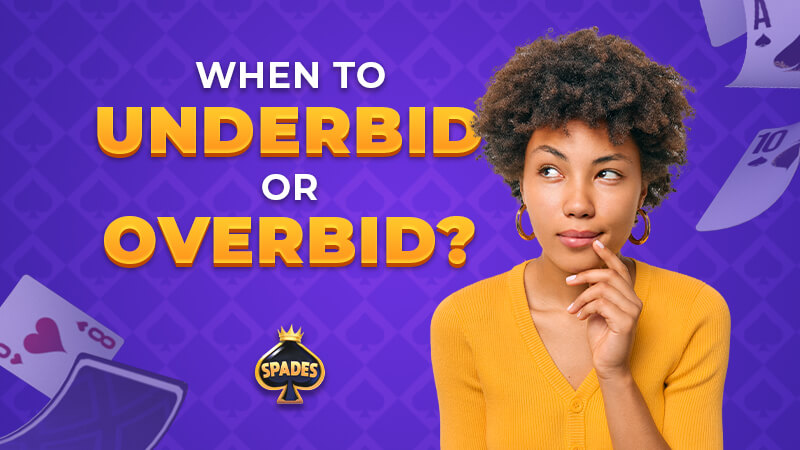In this blog post, we’ll break down the concepts of underbidding and overbidding, provide real-game examples, and explain the situations where each tactic can work to your advantage.
For a full breakdown of how the game works, check out our complete Spades rules guide.
1. What Does It Mean to Underbid or Overbid?
- Underbidding is when you bid fewer tricks than you think you can take.
- Overbidding is when you bid more tricks than you’re reasonably sure you can win.
Both tactics come with risks and rewards, and successful players use them intentionally depending on the game situation.
2. When to Underbid
Underbidding is typically used to:
- Avoid bag penalties
- Sandbag opponents
- Play conservatively in a winning position
Example 1: Avoiding a Bag Penalty
Let’s say you and your partner have 8 bags and are currently leading the game with 430 points. You estimate you can win 4 tricks, but if you end up taking 6, you’ll hit 10 bags and lose 100 points.
Strategy:
Bid only 3 tricks instead of 4 or 5. This gives you room to “dump” a trick or two and avoid crossing the bag penalty threshold.
Example 2: Letting Opponents Break Their Bid
You’re dealt a decent hand with 5 solid tricks, but you suspect the opponents have overbid based on previous patterns. Instead of bidding 5, you go with 3.
If you quietly collect your tricks while the opponents struggle to meet their high bid, you can gain a scoring advantage without drawing attention.
3. When to Overbid
Overbidding is more aggressive and risky, but it can be useful when:
- You’re trying to close a point gap
- You want to apply pressure
- You’re trying to avoid giving up control of the hand
Example: Making Up Ground Fast
You and your partner are trailing with only 260 points while your opponents are at 430. Your hand looks like 3 solid tricks, but you push for a bid of 5.
If your team wants a chance to catch up, playing it safe won’t be enough. Overbidding forces you to go big – and if you succeed, you close the point gap faster.
4. Pro Tips for Smart Bidding
1. Know the score. Always be aware of your and your opponent’s score, especially bag count and the points needed to win.
2. Read your partner’s bidding habits. Consistency in team bidding helps avoid overlapping bids or unintentional sandbagging.
3. Watch the nil bids. Both underbidding and overbidding can be used to counter a nil bid strategy.
4. Use overbidding when behind, underbidding when ahead. This is not a strict rule, but a helpful guideline for momentum control.
Mastering when and why to underbid or overbid gives you an edge, turning a good player into a great one. The next time you sit down at the Spades table – virtual or real – think a few moves ahead and bid with purpose.
Want to test your bidding strategy?
Play Spades online at VIP Spades and sharpen your skills against players from around the world!


